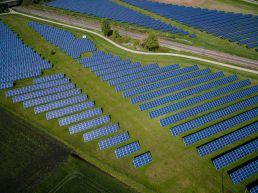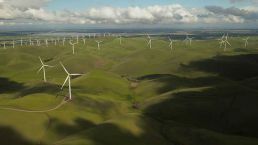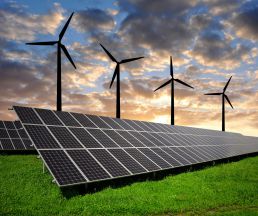Natural Gas
What Is the Gas Industry?
Over millions of years, the remains of plants and animals (such as diatoms) built up in thick layers on the earth’s surface and ocean floors. Over time, these layers were buried under sand, silt, and rock. Pressure and heat changed some of this carbon and hydrogen-rich material into coal, some into oil, and some into natural gas.
Specifically focusing on natural gas (the cleanest fossil fuel), its largest component gas is methane, a compound with one carbon atom and four hydrogen atoms (CH4). Natural gas also contains smaller amounts of natural gas liquids (NGLs) and non-hydrocarbon gasses, such as carbon dioxide and water vapor.
Natural gas systems include wells, gas gathering and processing facilities, storage, as well as transmission and distribution pipelines. These components are all important aspects of getting natural gas out of the ground and to the end user.
Natural gas systems encompass the following industry segments:
- Production: Getting raw natural gas from underground formations.
- Gathering and Processing: This involves stripping out impurities and other hydrocarbons and fluids to produce pipeline grade natural gas that meets specified targets. Pipeline quality natural gas is 95% to 98% methane).
- Transmission: This encompasses delivering natural gas from the wellhead and processing plants to city gate gas stations and/or industrial end users. Transmission occurs through a vast network of high pressure pipelines. Natural gas storage falls within this sector. Natural gas is typically stored in depleted underground reservoirs, aquifers, and salt caverns.
- Distribution: Delivery of natural gas from the major pipelines to the end users.
Why Invest in Gas?
The reason for investing in the natural gas industry is very basic – increasing demand and limited supplies.
In its International Energy Outlook 2021, the U.S. Energy Information Administration (EIA) predicted a nearly 50% increase in global energy use from 2020 to 2050. This is primarily a result of projected economic and population growth in the developing world, particularly in Asia.
Global natural gas demand is forecast to grow by 50% to 5.92 trillion cubic meters by 2050 from 2019 levels, the Gas Exporting Countries Forum said about a year ago in its Global Gas Outlook.
Its forecast for gas demand growth is broadly in line with forecasts from other organizations on an annualized basis. The International Energy Agency (IEA) sees global gas consumption reaching 5.22 trillion cubic meters by 2040. S&P Global Platts Analytics forecast global gas demand at 5.29 trillion cubic meters in the same time frame.
LNG (liquified natural gas) is set for strong growth, as domestic supply in key gas markets will not keep up with demand growth. LNG demand is expected to grow 3.4% a year to 2035, with some 100 million metric tons of additional capacity required to meet both demand growth and decline from existing projects. LNG demand growth will slow, but will still grow by 0.5% from 2035 to 2050, with more than 200 million metric tons of new capacity required by 2050.
All this demand has run smack into a lack of investment in the industry.
Moody’s recently released research in which it found the energy industry will need to increase its capital investments by as much as 54% to avoid a major supply crunch in the coming years. The firm estimated that the $352 billion of industry capital investment during 2021 would need to rise to $542 billion in order to keep pace with new demand.
Moody’s report is consistent with earlier reports by Rystad Energy and Wood MacKenzie estimating the industry has been under-investing since 2015 in the finding and development of new reserves that will be needed to meet rising demand.
How to Invest in Gas
So how can you invest into the natural gas industry and its bullish fundamentals?
Exchange traded funds (ETFs) are one possibility, as is buying a futures contract or investing in natural gas stocks.
There are five natural gas ETFs to choose from currently. Please note that some ETF investments offer exposure to both the oil and gas markets simultaneously.
If you decide to invest in natural gas futures, keep your eyes peeled on Thursdays, when the U.S. Department of Energy releases its weekly natural gas storage report.
Lastly, investors can opt to invest in companies involved in the natural gas market. As with ETFs, many companies that are exploring for or producing natural gas are also focused on oil. It is difficult to find companies that are aimed purely at natural gas.
For help in finding natural gas-related investments, make sure you check out the magnifi.com website.
Unlock a World of Investing
with a Magnifi Account
Magnifi is changing the way we shop for investments, with the world’s first semantic search engine for finance that helps users discover, compare and buy investment products such as ETFs, mutual funds and stocks. Open a Magnifi investment account today.
The information and data are as of the January 10, 2022 (publish date) unless otherwise noted and subject to change. This blog is sponsored by Magnifi.
Oil Industry
Crude oil or petroleum are called fossil fuels because they are mixtures of hydrocarbons that formed from the remains of animals and plants (diatoms) that lived millions of years ago in a marine environment. Over millions of years, the remains of these animals and plants were covered by layers of sand, silt, and rock. Heat and pressure from these layers turned the remains into what we now call petroleum, which means rock oil or oil from the earth.
The vast majority of crude oil is refined and used by the transportation industry to power our cars, trucks, planes, boats, etc. Crude oil is also used for heating oil, petrochemical feedstocks, waxes, lubricating oils, and asphalt.
Oil is measured in barrels (bbl). One barrel is about 100–200 liters (26–53 gallons). According to the U.S. Energy Information Agency (EIA), in 2020, total U.S. petroleum production averaged about 18.375 million barrels per day, of which 11.283 million barrels per day of crude oil was produced.
What Is the Oil Industry?
After crude oil is removed from the ground, it is sent to a refinery where different parts of the crude oil are separated into usable petroleum-based products. These products include gasoline and distillates.
There are two benchmarks for oil globally. Here in the U.S., the benchmark is WTI (West Texas Intermediate). It is a light, sweet, high-quality crude that is easy to refine.
The other is Brent crude, which is the benchmark for European, African and Middle Eastern crude oil.
The term “sweet crude” refers to petroleum that has less than 1% sulfur content. Both WTI and Brent crude are lighter, or less dense, compared to other crude oils available. In addition, their sulfur content is well under 1%, making them simpler to refine into products like gasoline. Because of this, they sell for higher prices on commodity markets.
Why Invest in Oil?
The reason to invest in oil is straightforward – it remains the lifeblood of the global economy. The fossil fuel industry generates an estimated $3.3 trillion in revenue globally every year.
That’s because, to date, there are yet not enough sources of alternative forms of energy to power the global economy.
This is especially important in the light of the forecast from the EIA that global energy demand will rise by 47% over the next thirty years.
In addition, for various reasons, oil companies have NOT invested enough into finding enough oil to meet the world’s energy needs. This spending hit a 15-year low in 2020.
Moody’s estimates that global annual upstream spending needs to increase by as much as 54% to $542 billion to avert the next supply shock.
Another reason to invest in oil over the shorter-term is inflation and possibly stagflation.
Historically, oil and inflation often go hand-in-hand. In the 1970s, skyrocketing oil prices sent inflation soaring. This forced the U.S. Federal Reserve to raise interest rates to nearly 20% to stop inflation.
Oil stocks have historically done well in periods of low economic growth and high inflation (stagflation).
How to Invest in Oil?
There are three main areas in the oil industry in which you can invest. These are:
- upstream – this is the business of oil exploration and production (E&P)
- midstream – this involves the transportation and storage of oil
- downstream – this includes the refining and marketing of petroleum products
In the upstream segment – in addition to the E&P companies themselves – there are drilling firms that contract their services to extract the oil and well-servicing companies that conduct construction and maintenance activities on well sites.
These service firms are ‘safer’ than the E&P companies themselves, which are high risk. That’s because E&P firms have high investment capital outflow, extended duration times to locate oil and drill for it. Virtually all cash flow and income statement line items of E&P companies are directly related to oil and gas production.
The midstream segment is often a safer investment. These businesses are focused solely on transporting and storing oil. Midstream companies may include shipping, trucking, railroads, pipelines, and storage tanks. The midstream segment is characterized by high regulation (particularly on pipeline transmission) and low capital risk.
The downstream businesses are the refineries. These are the companies responsible for removing impurities and converting the oil to products for the general public, such as gasoline, jet fuel, heating oil, and asphalt.
In summary, oil is a vital cog for the well-being of the global population and a necessity for economic progress. It is also essential to our daily lives. We’re reliant on oil to power our cars and trucks and so many other necessary things.
A good way to invest in the industry is through exchange traded funds (ETFs). A number of which can be found on Magnifi.
Unlock a World of Investing
with a Magnifi Account
Magnifi is changing the way we shop for investments, with the world’s first semantic search engine for finance that helps users discover, compare and buy investment products such as ETFs, mutual funds and stocks. Open a Magnifi investment account today.
The information and data are as of the January 7, 2022 (publish date) unless otherwise noted and subject to change. This blog is sponsored by Magnifi.
Sustainability
What Is Sustainable Investing?
Sustainability – a company’s ability to create positive environmental and societal impact – is rapidly reshaping the corporate landscape. It is reshaping whole industries and generating new waves of growth.
The staggering scale of the disruption (and opportunities) that will play out over the next few decades are why many company executives right now are strategizing as to how to position their companies for the future in the face of ongoing megatrends, such as climate change.
More and more governments, as well as corporations, are pledging to back a United Nations campaign aiming for net-zero greenhouse gas emissions. This will affect how nearly every company operates.
Just the push to limit global temperature increases to under 2°C—the number one sustainability challenge of our time—will drive a massive transformation of the global economy. It will require investments totaling an estimated $100 trillion to $150 trillion by 2050.
Tomorrow’s best companies will be those that can operate outside of their comfort zone. Why? At its core, sustainability has a lot to do with resiliency.
Companies must build the capacity to adapt and innovate amid worldwide disruptions. In effect, sustainability requires “unlearning” how industrial society has operated for 150 years, and charting a new route to reach the same goal of delivering shareholder value.
Going forward, C-suite executives and boards must treat social responsibility and environmental stewardship not as separate functions largely disconnected from strategy, but rather as integral to corporate and business strategy.
Differences Between Sustainable Investing, Socially Responsible Investing, & ESG Investing
Sustainable Investing, Socially Responsible Investing (SRI), and ESG Investing are often used interchangeably. However, these investment approaches are each different.
Sustainability has become a catch-all term for a company’s efforts to “do better” or “do good.” This investment approach has three basic pillars: economic growth, environmental protection, and social progress. At times, this is referred to as “people, planet, and profits.” In a nutshell, sustainable investing directs capital to companies fighting climate risk and environmental destruction, while also promoting corporate responsibility.
In general, SRI investors encourage corporate practices that are morally grounded and promote environmental stewardship, consumer protection, human rights, and racial/gender diversity. Essentially, for socially responsible investors, morality trumps the bottom line.
ESG investing also focuses on three pillars. Environmental issues, which can include pollution, climate change, extreme weather, carbon management, and use of scarce resources. Social issues, which can include product safety, human rights, worker safety, customer data protection, and diversity and inclusion. Governance issues, which can include factors such as accounting standards compliance, anti-competitive behavior, and a strong ESG management process.
ESG data and metrics are used to gain insights into the success and value of a company’s performance and policies in order to mitigate risk and identify superior risk-adjusted returns. Essentially, the focus of ESG investing is on increasing the bottom line through investments in responsible companies that are being well managed.
Why Choose Sustainable Investing?
This type of investing has become Wall Street’s hottest growth area.
According to data supplied by The Forum for Sustainable and Responsible Investing, there are nearly $13 trillion invested into some form of socially responsible investing. And according to research conducted by Morgan Stanley in 2019, 85% of individual investors and 95% of millennial investors are interested in sustainable investing.
Sustainable investing makes a lot of sense, even if your only concern is the return on the money you are investing.
Like the tortoise in the fabled race with the hare, long-term investors are seeing growing evidence that this type of investing can beat traditional methods. For example, in the past few years, companies with higher ESG ratings had higher average return on invested capital, compared to companies with lower ratings, according to MSCI.
The reason for this outperformance is straightforward and obvious… ESG pushes companies to look beyond the next quarter or even the next three- to five-year business cycle in evaluating risk.
Even the results from the tough first half of 2020 were good. Morningstar said, “an impressive 72% of sustainable equity funds rank in the top halves of their Morningstar categories and all 26 ESG (environmental, social, and governance) index funds have outperformed their conventional index-fund counterparts.”
How to Participate in Sustainable Investing
With the large number of companies touting their sustainability credentials, you would need a ‘scorecard’ to keep track. A much easier route would be to purchase ETFs or mutual funds that invest in companies with specific sustainability goals. A simple search on Magnifi indicates numerous ways for investors to access sustainable funds with low fees.
Unlock a World of Investing
with a Magnifi Account
Magnifi is changing the way we shop for investments, with the world’s first semantic search engine for finance that helps users discover, compare and buy investment products such as ETFs, mutual funds and stocks. Open a Magnifi investment account today.
The information and data are as of the November 8, 2021 (publish date) unless otherwise noted and subject to change. This blog is sponsored by Magnifi.
Energy
Energy is vital for the well-being of the global population and a necessity for economic and social progress. It is also essential to our daily lives. We’re reliant on energy to power our cars and trucks, heat and cool our homes and offices, wash our clothes, manufacture goods, etc.
As the global population continues to grow, so will the demand for energy. Which is why investing in the energy sector could be an important move for your portfolio in years to come.
What is the Energy Market?
The energy market is composed of a large group of companies that produce or supply energy. It includes drillers, refiners, producers, companies providing equipment & services, and exploration companies in the oil & gas sector. The sector also includes integrated power utility companies such as renewable energy.
Investing in non-renewable energy provides exposure to natural gas, petroleum, and coal. Uses included heating and electricity generation, fuel for transportation, feedstocks for chemicals/plastics/synthetic materials. The major advantages of non-renewable energy are its reliability and ease of extraction, given that it is not weather-dependent, and can be accessed through drilling (onshore and offshore), mining, and fracking (hydraulic fracturing). Currently, about 85 percent of the world’s energy comes from nonrenewable fossil fuels—oil, natural gas, coal.
Renewable energy offers exposure to solar, wind, biofuels, geothermal, and hydropower. In the United States, renewable energy sources currently provide for 12% of total U.S. energy consumption and about 20% of electricity generation. These percentages are expected to grow significantly as public and private sectors shift away from fossil fuels.
Why Invest In Energy?
Presently there are 7.9 billion people inhabiting the world and it’s projected that number will reach 9 billion by 2037. Which is why it’s no surprise that in 2018 the U.S. Energy Information Administration (EIA) released a report that projected that global energy consumption will grow by nearly 50% by 2050.
The EIA also predicts that the share of renewables in the U.S. electricity generation mix will increase from 21% in 2020 to 42% in 2050. Solar and wind generation are responsible for most of that growth. Solar power is forecast to account for almost 80% of the increase in the US’s renewable electricity generation through 2050. And according to Global Market Insights, the global wind energy market should grow by more than 69% from 2021-2027.
You might think that because of these impressive growth forecasts for renewable energy that the non-renewable energy market will begin to shrink but that’s not the case. The transition away from non-renewable energy will not happen overnight, and will be measured in decades, not years. This is attributed to technological advancements that make oil and natural gas cost-competitive to extract, a lack of infrastructure to support complete green energy deployment, and the fact that a significant portion of end-use demand for oil has limited alternatives. The EIA is forecasting oil prices to be 25% higher by 2030 and 86% higher by 2040. They also predict that the natural gas share of the U.S. electricity generation mix will remain at about one-third of total generation from 2020 to 2050.
How To Participate In Energy Investing?
Picking individual stocks in the energy sector can be tempting with the potential for high returns for early investors. However, diversification is the superior strategy, as not all energy stocks will be winners. Therefore, the best solution is gaining exposure to the sector through energy-focused ETFs and mutual funds. A simple search on Magnifi indicates numerous ways for investors to access energy funds with low fees.
Unlock a World of Investing
with a Magnifi Account
Magnifi is changing the way we shop for investments, with the world’s first semantic search engine for finance that helps users discover, compare and buy investment products such as ETFs, mutual funds and stocks. Open a Magnifi investment account today.
The information and data are as of the October 13, 2020 (publish date) unless otherwise noted and subject to change. This blog is sponsored by Magnifi.
Wind Energy
Unlock a World of Investing with a Free Magnifi Account
While wind energy as a reliable and standard resource may seem far off, the technology is being adopted at record speed. In fact, wind energy is one of the fastest-growing energy sources in the world, according to the U.S. Department of Energy.
That’s especially true for 2020, a banner year for the wind industry, according to a report by American Clean Power (ACP).
In the fourth quarter of 2020 alone, the U.S. wind industry installed 10,593 megawatts of new wind power capacity—the highest quarter on record. In fact, that’s more wind power capacity installed than in any given year except 2012.
Texas led with 2,197 megawatts installed, followed by Wyoming with 895 megawatts, Oklahoma with 866 megawatts, Iowa with 861 megawatts, and Missouri with 786 megawatts.
Who is investing in all of this wind? Developers commissioned 16,913 megawatts, representing an 85% increase over 2019. Project owners commissioned 54 new projects across 20 states in the fourth quarter.
This rapidly accelerating trend is being driven by a combination of increased policy initiatives, more scalable technologies, increased demand from corporate and residential customers alike, and more positive customer perception overall. The Biden Administration’s climate plan, for example, includes the ambitious goal of becoming carbon-neutral by 2035. To achieve that, renewables like wind energy will need to become increasingly less fringe as they move to permanently replace fossil fuel power.
What is wind energy?
Unlock a World of Investing with a Magnifi Account
Magnifi is changing the way we shop for investments, with the world’s first semantic search engine for finance that helps users discover, compare and buy investment products such as ETFs, mutual funds and stocks. Open a Magnifi investment account today.
The information and data are as of the November 17, 2020 (publish date) unless otherwise noted and subject to change. This blog is sponsored by Magnifi.
Geothermal Energy
Unlock a World of Investing with a Free Investment Trading Account
Geothermal energy is nothing new. It goes back as far as the first century A.D. in Pompei, where baths were heated by hot springs.
And it’s already powering major cities in the modern world. For example, Iceland’s capital city, Reykjavik, which has long been considered one of the cleanest cities in the world, heats 95 percent of its buildings using geothermal energy.
In Paris, the Dogger Aquifer has supplied geothermal heat and hot water since 1970. It currently supplies 210,000 housing units. In mid-2021, drilling is set to begin in Paris on another geothermal well.
In Munich, officials of the utility company Stadtwerke München (SWM) want to expand the geothermal district to 560,000 households.
In the US, Boise, Idaho is home to the largest geothermal heating system in the country. The system heats 6 million square feet for only about $1,000 a month, which pays for the electricity to pump it. Boise sits by a unique resource— a geological fault where 177-degree Fahrenheit water rises to the surface in the foothills just outside of town.
But geothermal energy doesn’t require a warm, babbling brook nearby. In fact, “the US already produces 3.7 gigawatts (GW) of geothermal electricity, or enough to power more than 1 million homes,” according to a report by Yale Environment 360.
These days, investors, government sectors, and oil and gas companies are getting on board the geothermal energy potential. Here’s what investors should know.
What Is Geothermal Energy?
Heat exists in the earth’s mantle around the world, no matter where you are standing.
That’s because geothermal heat comes from the Earth’s core, where temperatures may reach 4,000-7,000°C. For perspective, the surface of the sun is approximately 5600°C (but at its core can reach more than 15,000,000°C).
While geothermal heat can naturally rise to the earth’s surface water through fissures, cracks and permeable rock, those presentations aren’t necessary to access the energy. Even in locations that don’t have readily available resources that reach the surface, the heat from the earth’s core can still be made accessible.
This is because deep drilling techniques allow hot water that sits two to three miles below the surface to be pumped and used to heat or to generate electricity.
The fact that geothermal heat is everywhere under our feet means that there is an “enormous untapped potential” for geothermal energy consumption.
Why Invest in Geothermal Energy?
While wind and solar energy might come to mind more quickly when talking about renewables, geothermal could far outpower these. In part that’s because unlike the sun or the wind, geothermal energy is “always on,” per the US Department of Energy.
Chief Marketing Officer for Baseload Capital, an investment firm in Sweden focusing on geothermal projects, referred to the geothermal industry as “the sleeping giant.” This is because geothermal energy can provide significant energy resources at all hours of the day, combating climate change in a real way.
According to the US Department of Energy report, GeoVision: Harnessing the Heat Beneath Our Feet, geothermal technology has enormous potential in the US. Instead of electric-powered air conditioners and natural gas-powered heaters, for example, geothermal powered heating and cooling solutions can power American homes.
In order for geothermal energy to reach its potential in the US, three things have to happen according to the US Department of Energy report: (1) increased access to geothermal resources, (2) reduced costs and improved economics for geothermal projects, and (3) improved education and outreach about geothermal energy. According to the report, by overcoming these technical and financial barriers, electricity generation through geothermal methods could increase 26-fold by 2050, providing 8.5 percent of the United States’ electricity, as well as direct heat.
The US isn’t the only country looking underground to solve energy problems. In Europe, the output of geothermal energy supply could increase eight-fold by 2050, according to the International Renewable Energy Agency (IRENA).
The good news is that when it comes to drilling, oil and gas companies know a lot. They, too, are looking at geothermal energy these days.
In 2021, oil and gas companies may finally start investing in geothermal. This is true as geothermal economics begin to improve, and after oil and gas underperformed from 2014 - 2020. Both BP and Chevron, for example, backed a $40 million funding round for Eavor, a Canadian geothermal energy firm, in early 2021. Eavor’s technology offers a closed-loop system that can potentially scale geothermal production, producing “enough heat for the equivalent of 16,000 homes with a single installation.”
Governments are also backing research around the world.
In Utah, the Frontier Observatory for Research in Geothermal Energy (FORGE), funded by the US Department of Energy, is an underground research laboratory. It just completed drilling its first well at a 65° angle from vertical reaching true vertical depth of 8,559 feet. The laboratory offers a test environment for future Enhanced Geothermal Systems (EGS) projects around the world that enable access to geothermal in locations that don’t have babbling warm brooks nearby, but rather require complicated drilling to access geothermal energy.
Breakthrough Energy Ventures, a fund backed by Bill Gates and other notable billionaires recently invested an additional $30 million in the startup Dandelion Energy, which heats homes with geothermal.
When it comes to geothermal energy, it is less a matter of if and more a matter of when technology is able to fully harness the energy beneath the surface of the Earth. With the number of potential disruptive and scalable technologies, eager large-scale investors, increasing public knowledge, and climate change imperative, geothermal will be getting more attention in the decades to come.
[/vc_column_text]
Unlock a World of Investing with a Free Investment Trading Account
Magnifi is changing the way we shop for investments, with the world’s first semantic search engine for finance that helps users discover, compare and buy investment products such as ETFs, mutual funds and stocks. Open a Magnifi investment account today.
The information and data are as of the April 6, 2021 (publish date) unless otherwise noted and subject to change. This blog is sponsored by Magnifi. This material is provided for informational purposes only and should not be construed as individualized investment advice or an offer or solicitation to buy or sell securities tailored to your needs. This information covers investment and market activity, industry or sector trends, or other broad-based economic or market conditions and should not be construed as investment research or advice. Investors are urged to consult with their financial advisors before buying or selling any securities. Although certain information has been obtained from sources believed to be reliable, we do not guarantee its accuracy, completeness or fairness. Past performance is no guarantee of future results. This content may not be reproduced or distributed to any person in whole or in part without the prior written consent of Magnifi. As a technology company, Magnifi provides access to tools and will be compensated for providing such access. Magnifi does not provide broker-dealer or custodial services.
Sustainable Energy (Alternative)
Unlock a World of Investing
with a Magnifi Account
Renewable energy has a presence on both the American and the global stages with lots of room for growth. Perhaps unexpectedly, the pandemic did not slow renewable energy down. Instead, the public health crisis that seemed to stop the world in many ways actually accelerated the transition to renewables and away from fossil fuels.
Part of that growth might be credited to Corporate and Environmental, Social and Governance (ESG) investment funds, which have clearly demonstrated that adopting renewables is good business, according to Duke Energy.
2020 was the year that renewable energy generation established itself as the cheapest, at-scale, proven energy option available, exceeding coal-fired energy production, also according to Duke Energy.
And that was before the Biden administration announced its ambitious goals for renewables and alternative energy.
Renewable energy is anticipated to keep growing in 2021, especially considering the Biden administration’s stated goals of (1) achieving a 100% clean energy economy and (2) reaching net-zero emissions no later than 2050. To achieve this, the Biden administration has resubmitted the US to the Paris climate agreement as well as implemented executive orders to move the country away from reliance on oil and gas and toward renewables.
These policies include lowering or eliminating existing subsidies on fossil fuels as well as funding renewable sector investments designed to help spur job growth in both the solar and wind industries.
Alternative energy is becoming the norm and, now more than ever, is clearly the future. Here are the alternative energy sources that all investors should consider.
What Is Sustainable Energy?
Alternative and renewable energy is energy that is generated by natural resources that readily replenish: the warmth of the sun, the blow of the wind, the movement of water, and the heat inside the earth to name a few. These resources do not generate greenhouse emissions.
During the first five months of 2020 alone, renewable energy provided 25.3% of electricity in the US. That is more than a sliver of the energy pie, and it’s growing.
The 7 types of renewable energy include solar, wind energy, hydroelectric, ocean, geothermal, biomass, and hydrogen. According to Duke Energy, the leading commercial renewable energy sources (ranked by market share and growth) include: wind, hydropower, solar, geothermal, and other technologies bolstering the renewable transition.
Wind
Wind and solar are expected to supply 70% of new power plant capacity built in 2021. Wind energy, unlike some other renewable resources, is available nationwide. It has the potential to be a viable source of renewable electricity in every state by 2050, according to the Wind Vision Report published by the Office of Energy Efficiency and Renewable Energy.
In the case of wind power, new (gigantic) turbines are providing more promise than ever. G.E.’s latest wind turbines have a rotor with a turning diameter longer than two football fields. Compared to the largest turbines currently in service, they generate about one third more power. Compared to the first machines of their kind installed offshore in Denmark in 1991, they generate 30 times as much power. As wind energy infrastructure improves and becomes more widespread, wind energy will no doubt grow its market share.
Hydropower
Hydropower uses moving water to generate electricity. Hydropower accounts for 52% of the nation’s renewable electricity generation and 7% of total electricity generation, according to the National Hydropower Association. While hydropower infrastructure tends to be dated (think dams, etc.), its power generation capacity is still very relevant. Even more, hybrid hydropower/solar plants (where floating solar panels are installed on the water of reservoirs, etc. that power dams) are becoming increasingly popular.
Solar
Despite the pandemic-induced economic downturn, solar installations increased in 2020. Solar generation is expected to account for 48% of US renewable generation by 2050, which would make it the fastest growing renewable power source, according to the Center for Climate and Energy Solutions.
No doubt, President Biden’s policies will further expand the industry. His initiatives to spur the industry include a review of Section 201 solar tariffs, countervailing duties, and anti-dumping laws by the International Trade Commission. If these tariffs are reduced or repealed, it could have an enormous impact on the development of solar energy.
It is also expected that tax credits and low interest financing available in the down economy will make solar energy installation more accessible both commercially and residentially in the year to come.
Geothermal
Geothermal energy, or heat from the earth, can be extracted by drilling deep wells to warm underground water sources. While geothermal energy lags behind wind and solar, it has enormous potential, with the U.S. leading in geothermal energy production.
Although geothermal energy might not seem as “front page” as renewables like solar and wind, it is getting investment attention. Breakthrough Energy Ventures, an investment firm that funds technologies that seek to limit carbon emissions (with backers including Jeff Bezos and Bill Gates) notably back geothermal technologies. Companies that have received investment include Dandelion Energy, which installs geothermal-powered heating and cooling systems for residential homes.
Other Technologies
There are a host of other industries that will support the transition to a more renewable-based economy. These include effective energy storage (capturing and storing energy to use it at another time), fuel cells (which generate power with fuel), increased energy efficiency that reduces the need for energy generation), and electrification.
There was a time when commercializing renewable energy seemed as far off as a flying car. But, that’s no longer the case. As more industries adopt renewable infrastructure, more companies strive to be green, and more consumers and investors demand both, the alternative energy industry will become increasingly mainstream.
Unlock a World of Investing
with a Magnifi Account
Magnifi is changing the way we shop for investments, with the world’s first semantic search engine for finance that helps users discover, compare and buy investment products such as ETFs, mutual funds and stocks. Open a Magnifi investment account today.
This blog is sponsored by Magnifi. The information and data are as of the February 10, 2021 (publish date) unless otherwise noted and subject to change.









